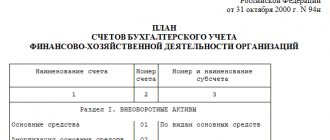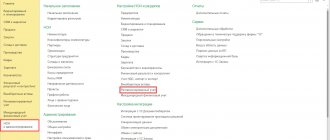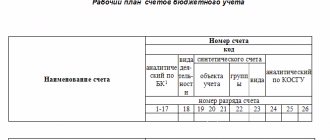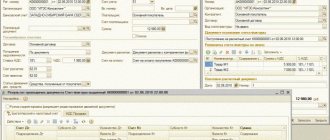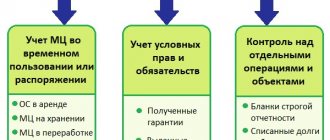What is a chart of accounts?
Charts of accounts are consolidated documents approved by regulatory legal acts at the federal level.
There are several industry-specific types of relevant documents. Thus, the chart of accounts for the commercial sector was approved by order of the Ministry of Finance of Russia dated October 31, 2000 No. 94n. Russian taxpayers must use this document as the basis for creating an internal accounting work plan (paragraph 4 of the Instructions for using the chart of accounts, approved by Order No. 94n).
The accounting plan is a key source for completing the documents that make up the organization's balance sheet. A little later we will look at how their components relate to each other.
In accordance with the internal work plan accounts, firms operating in the Russian Federation carry out standardized accounting of various business transactions related to asset management, fulfillment of obligations, expenditure of funds, extraction of income, etc.
The main elements of the chart of accounts approved by the Ministry of Finance for private companies are as follows:
- numbers and names of main accounts;
- numbers and names of subaccounts.
When forming its own work plan, the organization does not have the right to change the first 2 parameters, but the parameters of subaccounts can. If necessary, the firm can also approve additional subaccounts.
As a rule, to effectively reflect business transactions, the accounts proposed by the Ministry of Finance require further detail. The company can do this by introducing its own analytical accounts, supplementing those recorded in Order No. 94n.
In the Guide to Account Correspondence from ConsultantPlus, you will find typical transactions for any account. If you do not have access to the K+ system, get a trial online access for free.
Let's look at what other accounting plans there are.
Basic accounting accounts (characteristics, table)
The accounting accounts that Russian enterprises need to use have been approved by several sources. Non-governmental organizations (except for banks and non-credit financial institutions) must use accounts put into effect by Order of the Ministry of Finance of the Russian Federation on October 31, 2000 No. 94n.
This regulatory act establishes the use of accounts:
- synthetic;
- synthetic subaccounts;
- off-balance sheet;
- off-balance sheet subaccounts.
Enterprises covered by Order No. 94n should use synthetic accounts approved by the Ministry of Finance for accounting purposes. The company, in turn, can develop and use its own subaccounts entirely.
This rule has also been established for those enterprises that have the right to conduct simplified accounting: even without the classical scheme of using double entry (an alternative to it may be the procedure proposed in clause 4.2 of the Ministry of Finance information No. P-3-3/2012), companies are recommended to use those synthetic accounts , which are approved in order No. 94n.
Off-balance sheet - should be used if the company carries out business transactions that correspond to their meaning (it can also supplement account data and create its own sub-accounts for them). Note that transactions using off-balance sheet accounts and subaccounts for them are recorded in accounting without applying the principles of double entry.
Let's look at the table of accounting accounts that the Ministry of Finance recommends for commercial enterprises to use.
| Synthetic account number | Used to reflect business transactions | Active | Passive | Active-passive |
| 01 | With fixed assets | ˅ | ||
| 02 | By depreciation of OF | ˅ | ||
| 03 | For profitable investments in materiel values | ˅ | ||
| 04 | With intangible assets | ˅ | ||
| 05 | By depreciation of intangible assets | ˅ | ||
| 07 | With equipment for installation | ˅ | ||
| 08 | With investments in non-current assets | ˅ | ||
| 09 | With assets classified as tax (deferred) | ˅ | ||
| 10 | With materials | ˅ | ||
| 11 | With bred animals | ˅ | ||
| 14 | With reserves for reducing the cost of inventory items | ˅ | ||
| 15 | For the procurement and purchase of goods and materials | ˅ | ||
| 16 | With facts of deviations in the cost of goods and materials | ˅ | ||
| 19 | By calculating VAT on purchased assets | ˅ | ||
| 20 | With main production facilities | ˅ | ||
| 21 | With semi-finished products of our own production | ˅ | ||
| 23 | With auxiliary production facilities | ˅ | ||
| 25 | With general production costs | ˅ | ||
| 26 | With general business expenses | ˅ | ||
| 28 | With facts of detection of defects during the release of goods | ˅ | ||
| 29 | With objects within service industries (or farms) | ˅ | ||
| 40 | For the release of goods, services or works | ˅ | ||
| 41 | With goods | ˅ | ||
| 42 | As part of the application of trade margins | ˅ | ||
| 43 | With finished products | ˅ | ||
| 44 | With selling costs | ˅ | ||
| 45 | With shipped products | ˅ | ||
| 46 | With completed stages within work in progress | ˅ | ||
| 50 | Managing the company's cash register | ˅ | ||
| 51 | On the use of enterprise current accounts | ˅ | ||
| 52 | On the use of foreign currency accounts of the organization | ˅ | ||
| 55 | On the use of special accounts in financial institutions | ˅ | ||
| 57 | With translations on the way | ˅ | ||
| 58 | With financial investments | ˅ | ||
| 59 | With reserves for reducing the cost of financial investments | ˅ | ||
| 60 | According to payments to suppliers | ˅ | ||
| 62 | According to settlements with buyers | ˅ | ||
| 63 | With reserves for debts with questionable status | ˅ | ||
| 66 | As part of settlements for loans classified as short-term | ˅ | ||
| 67 | As part of transactions for loans classified as long-term | ˅ | ||
| 68 | For transfer of payments to the budget (for taxes, fees) | ˅ | ||
| 69 | As part of settlements for the transfer of funds to extra-budgetary funds | ˅ | ||
| 70 | According to salary calculations with staff | ˅ | ||
| 71 | According to settlements with accountable employees | ˅ | ||
| 73 | For settlements with employees in other legal relations | ˅ | ||
| 75 | According to settlements with the founders of the company | ˅ | ||
| 76 | For settlements with debtors and creditors of the organization | ˅ | ||
| 77 | Upon fulfillment of deferred tax liabilities | ˅ | ||
| 79 | According to calculations classified as on-farm | ˅ | ||
| 80 | With the authorized capital of the enterprise | ˅ | ||
| 81 | With own shares (shares) | ˅ | ||
| 82 | With the company's reserve capital | ˅ | ||
| 83 | With additional capital of the company | ˅ | ||
| 84 | With the firm's retained earnings (uncovered losses) | ˅ | ||
| 86 | For targeted funding | ˅ | ||
| 90 | As part of the implementation | ˅ | ||
| 91 | For other income and expenses of the company | ˅ | ||
| 94 | To identify shortages and losses due to deterioration of values | ˅ | ||
| 96 | With reserves for upcoming expenses | ˅ | ||
| 97 | With expenses of upcoming periods | ˅ | ||
| 98 | With the income of the coming periods | ˅ | ||
| 99 | As part of the calculation of the company's profits and losses | ˅ | ||
| Off-balance sheet account number | Used to reflect business transactions | Not classified as active, passive or active-passive | ||
| 001 | With leased fixed assets | |||
| 002 | With inventory items accepted for storage | |||
| 003 | With materials taken for recycling | |||
| 004 | With goods taken on consignment | |||
| 005 | With equipment taken for installation | |||
| 006 | With BSO | |||
| 007 | With the debts of insolvent borrowers, which are written off at a loss for the company | |||
| 008 | As part of securing obligations, as well as payments received | |||
| 009 | As part of securing obligations, as well as payments issued | |||
| 010 | As part of the depreciation of fixed assets | |||
| 011 | With fixed assets that are leased | |||
Find out what and how to take into account on off-balance sheet accounts in ConsultantPlus. If you do not have access to the K+ system, get a trial demo access for free.
Which legal acts approved the charts of accounts for financial and economic activities?
We noted above that commercial organizations are required to formulate working accounting plans based on the provisions of Order No. 94n. This legal regulation can be supplemented by sources of law that adapt accounting legislation to the activities of certain categories of taxpayers. Among such regulations is Order No. 64n of the Ministry of Finance of Russia dated December 21, 1998, which approved recommendations for accounting for small enterprises.
The need for accounting is also legally established for state and municipal organizations. The main regulatory legal act establishing the accounting plan for such structures is Order of the Ministry of Finance of Russia dated December 1, 2010 No. 157n. There are also complementary sources of law:
- order No. 174n dated December 16, 2010, which approved the accounting plan for budgetary institutions;
- Order No. 183n dated December 23, 2010, which approved the accounting plan for autonomous institutions.
In turn, government organizations are required to work within the framework of budget accounting - a subtype of accounting, adapted mainly for accounting for non-commercial financial transactions. The corresponding chart of accounts is given in the order of the Ministry of Finance of Russia dated December 6, 2010 No. 162n.
A separate accounting plan was approved for banks operating in the Russian Federation by Regulation of the Central Bank of the Russian Federation dated February 27, 2017 No. 579-P.
A separate accounting plan for non-credit financial organizations, approved by the Bank of Russia dated September 2, 2015 No. 486-P. Non-credit financial structures include, in particular, insurance companies. Thus, in the Russian Federation several types of charts of accounts have been established. But the main one for the commercial sphere is traditionally considered to be the one approved by Order No. 94n. Let's study its features, in particular, determine who needs to use it.
Inventories: what to include, how to take into account
All company assets that have a useful life of less than 12 months should be classified as inventories.
For example, raw materials, materials, semi-finished products, components, packaging, fuel, inventory and other similar assets. To systematize and generalize information about the cost and quantitative indicators of inventories, account 10 “Materials” is used (Order of the Ministry of Finance No. 94n). These requirements apply to non-profit organizations, commerce and small businesses. State employees use accounting accounts in accordance with Instruction No. 157n. Material reserves in a budgetary institution are reflected in the accounting account of the same name 0 105 00 000.
It is permissible to take into account values in two ways: at actual cost (clause 62 of Order No. 119n) or at accounting prices using 15 and 16 accounting accounts (clause 80 of Order No. 119n dated December 28, 2001).
The company independently chooses the accounting method suitable for the specifics of its activities. This choice must be justified in the accounting policies of the institution. Also in the accounting policy, indicate the forms of primary and accounting documentation that will be used to reflect operations on the movement of money.
The method for writing off materials from the 10th account should also be written down in the accounting policy. Three methods are allowed:
- Based on the average cost of inventories.
- Based on actual unit cost.
- FIFO method.
The cost of inventories may include not only the actual price paid, but also other costs. For example, consulting services, non-refundable customs and tax duties, non-refundable VAT, delivery costs, and other costs associated with the receipt of goods.
Who should use the accounting chart of accounts
The accounting chart of accounts approved by Order No. 94n must be used by organizations that, in accordance with the law, are obliged, firstly, to maintain accounting, and secondly, to use the double entry method in the process of maintaining it. These are all business entities in the Russian Federation, except:
- IP;
- credit and state (municipal) institutions;
- branches and representative offices of foreign companies.
Individual entrepreneurs and branches of foreign companies have the right not to keep accounting records at all. Micro-enterprises and non-profit organizations may not use double entry and therefore not use the accounts recorded in Order No. 94n (clause 2.1 of the information of the Ministry of Finance of Russia No. PZ-3/2015). But in practice, this turns out to be not very convenient, so micro-enterprises, one way or another, still use accounts from those approved by the Ministry of Finance.
For some enterprises, the legislator establishes a preference in the form of the opportunity to maintain a simplified working chart of accounts. Let's consider this aspect in more detail.
Who should use the instructions from Order No. 94n
The source of law in question should be applied by default by all organizations that, in accordance with the law, must conduct accounting using the double entry method, that is, simultaneous recording of business transactions by debit and credit.
Instructions from order No. 94n in accordance with paragraph 2 of Art. 6 of Law No. 402-FZ may not be used:
- IP;
- branches of foreign organizations.
The reason is that the legislator allows these entities not to conduct accounting in principle.
Formally, micro-enterprises and non-profit organizations also have the right not to apply the instructions to the chart of accounts from Order No. 94n, since they may not make double entries in the accounting process (clause 2.1 of information No. PZ-3/2015). But in practice, taxpayers do not actively use this preference, since the legislator has not yet published official explanations, methods and recommendations regarding accounting without double entry.
Who can use the simplified chart of accounts?
In accordance with information from the Ministry of Finance of Russia No. PZ-3/2015, the preference in question can be used by:
- small businesses;
- NPO;
- companies operating in Skolkovo.
The use of a simplified accounting chart of accounts involves, first of all, reducing the number of synthetic accounts used in the structure of the work plan. Another relaxation is the ability not to use accounting registers in the work (clause 4.1 of information No. PZ-3/2015).
Chart of accounts table with subaccounts: correlation with the balance sheet
So, a significant part of Russian companies are required to work with a standard chart of accounts. The full accounting plan is reflected in order No. 94n in the form of a table. Its structure consists of 8 sections. Let's consider the connection between these sections, including accounts and subaccounts, with sections of the balance sheet.
The accounts of section 1 of the accounting plan are intended to reflect transactions with non-current assets. The balances on these accounts are the source of data for the formation of balance sheet lines in terms of non-current assets.
How to record entries for accounting for fixed assets, read the article “Accounting for fixed assets - accounting entries.”
The accounts of section 2 of the accounting plan are used to reflect business transactions on inventories. The account balance of section 2 is used to fill out the section reflecting current assets in the balance sheet. For a similar purpose, data from sections 3 “Production Costs”, 4 “Finished Products and Goods” and 5 “Cash” of the accounting plan is used.
The working chart of accounts must be fixed in the accounting policies of the organization.
The nuances of forming accounting policies are described in detail in a typical situation from ConsultantPlus. There you will also find an example of a working chart of accounts. If you do not have access to the K+ system, get a trial online access for free.
Read about the reflection of individual transactions in the accounts in our materials:
- “Account 26 in accounting (nuances)”;
- “Accounting for a corporate bank card”;
- “Special equipment in accounting - features and nuances”;
- “Business inventory in accounting is...”.
The indicators reflected in the accounts included in section 6 “Calculations” are used to reflect information about receivables and payables (including long-term ones).
How debt on contributions to the authorized capital is reflected, read the article “Accounting entries on contributions to the authorized capital.”
How to reflect the issuance of imprest amounts, look in the material “Transfer of subaccounts to an employee’s card from a current account.”
Sections 7 “Capital” and 8 “Financial Results” of the chart of accounts contain accounts that reflect data on capital, target financing, and the financial result of the organization.
For entries on accounting for financial results, see the article “Accounting and analysis of financial results.”
The procedure for reflecting retained earnings can be found in the article “Retained earnings in the balance sheet (nuances).”
Classification of synthetic accounts based on the requirements of regulatory documents
The chart of accounts and instructions for its use, approved by Order of the Ministry of Finance dated October 31, 2000 No. 94n, contain a complete list of accounts that are used for accounting.
Based on the presence of subaccounts, they can be divided into three groups:
| Group | Synthetic accounts included in the group |
| Accounts that contain subaccounts designated in the chart of accounts | 08, 10, 19, 41, 50, 55, 58, 69, 73, 75, 76, 79, 90, 91, 98 |
| Accounts that need to be divided into subaccounts according to the recommended criteria | 01, 03, 04, 66, 67, 68, 86, 96, 97 |
| Accounts that are presented in the chart of accounts only in synthetic form | 02, 05, 07, 09, 11, 14, 15, 16, 20, 21, 23, 25, 26, 28, 29, 40, 45, 44, 45, 46, 51, 52, 57, 59, 60, 62, 63, 70, 71, 77, 79, 80, 81, 82, 83, 84, 94, 99 |
Some accounts also have specific requirements for the analytics they must contain. From this point of view, accounts can be classified as follows:
| Group | Synthetic accounts included in the group |
| The instructions for the chart of accounts contain requirements for account detailing, which must be implemented using subaccounts | 01, 02, 03, 04, 08, 10, 14, 16, 19, 41, 42, 50, 52, 55, 57, 58, 59, 60, 62, 63, 66, 67, 68, 69, 73, 75, 76, 79, 83, 84, 90, 91, 96, 97, 98 |
| The instructions for the chart of accounts contain requirements for account analytics, which can be implemented using other characteristics (for example, in accordance with inventory and warehouse accounting, using separate warehouses, orders, cost centers, etc.), but without using subaccounts | 01, 02, 03, 04, 05, 07, 09, 10, 11, 15, 20, 21, 23, 25, 26, 28, 29, 40, 41,43, 44, 45, 46, 51, 60, 62, 70, 71, 77, 80, 86 |
| There are no requirements for analytics in the instructions | 81, 82, 94 |
The balance sheet accounts highlighted in the table should be detailed not only at the subaccount level, but also object by object. For example, account 01 (fixed assets) must contain information about those objects that are in operation, stock, conservation, or lease. This can be implemented at the subaccount level. But at the same time, there should also be analytics for inventory items.
ATTENTION! From 01/01/2022, PBU 6/01 “Accounting for Fixed Assets” will no longer be in force, and accounting for fixed assets will be regulated by two new FAS 6/2020 “Fixed Assets” and 26/2020 “Capital Investments”. Read more about them here.
Find out what changes to make to the accounting policy in accordance with the new Federal Accounting Standards in ConsultantPlus. If you do not have access to the K+ system, you can get trial demo access to the system for free.
For information about what other applications, in addition to the working chart of accounts, may be required for the accounting policy, read the articles:
- “We draw up a regulation on the accounting policies of the organization”;
- “Appendices to accounting policies - sample.”
One of the applications to the accounting policy is the document flow schedule. From 2022, FSBU 27/2021 “Documents and document flow” will become mandatory. ConsultantPlus will help you prepare a document flow schedule. ConsultantPlus experts explained in detail how to organize document flow for accounting purposes under the new FAS 27/2021. Get trial demo access to the K+ system and upgrade to the Ready Solution for free.
New chart of accounts for 2020-2021
Did the 2020-2021 year bring any legislative adjustments to the chart of accounts? The answer to this question depends on the scope of application of the relevant document.
Order of the Ministry of Finance of Russia No. 94n, used by commercial firms, was issued quite a long time ago - about 15 years ago. It can be noted that since that moment, changes have been made to it 3 times:
- by order No. 38n dated 05/07/2003;
- by order of September 18, 2006 No. 115n;
- by order of November 8, 2010 No. 142n.
Thus, the provisions of Order No. 94n have not been adjusted for almost 10 years. So there is no need to say that a new accounting plan for commercial firms has appeared in 2020-2021.
Another thing is state and municipal organizations. The legislator is very active in adjusting the accounting policies of budgetary structures, especially in the main regulatory legal act regulating accounting in budgetary structures - order No. 157n.
Read about changes in the Chart of Accounts for budgetary accounting in this material.
Read more about the structure of the budget accounting account in the article “Typical entries for budget accounting (examples)” .
Where can I download the chart of accounts?
You can download the current chart of accounts for commercial organizations on our website.
This document fully complies with the provisions of Order No. 94n.
Read about what a working chart of accounts for accounting might look like in the article “Working chart of accounts for accounting - sample 2022” .
Results
In the Russian Federation, various charts of accounts are used for budgetary, autonomous, government institutions, credit and non-credit financial organizations, and commercial organizations. For commercial organizations, the chart of accounts was approved by order of the Ministry of Finance of Russia dated October 31, 2000 No. 94n. Small enterprises can use a simplified chart of accounts recommended by the Ministry of Finance in order No. 64n dated December 21, 1998. Each organization must develop a working chart of accounts independently and approve it in its accounting policies.
Sources: order of the Ministry of Finance of the Russian Federation dated October 31, 2000 No. 94n
You can find more complete information on the topic in ConsultantPlus. Free trial access to the system for 2 days.
What's new in the instructions from order No. 157n
Amendments to Order No. 157n mainly consist of changing the structure of accounts contained in a single plan. The latest regulatory legal acts, through which the legislator edited Order No. 157n, as well as the instructions for the chart of accounts, are orders of the Ministry of Finance of Russia dated 08/06/2015 No. 124n, dated 03/01/2016 No. 16n, dated 11/16/2016 No. 209n.
The range of amendments to order No. 157n is quite wide:
- adding and deleting accounts;
- adjusting account names;
- providing organizations with the opportunity to independently decide on the possibility of opening additional off-balance sheet accounts.
Read more about budget accounting in the articles:
- “Drawing up a chart of accounts for budget accounting - sample”;
- “Typical entries for budget accounting (examples)”.
You can find more complete information on the topic in ConsultantPlus. Free trial access to the system for 2 days.
